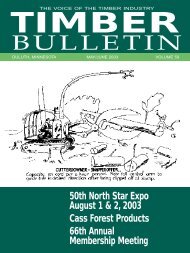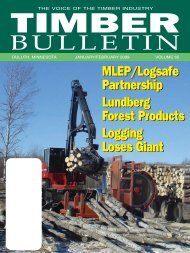Timber Bulletin Nov/Dec - Minnesota Forest Industries
Timber Bulletin Nov/Dec - Minnesota Forest Industries
Timber Bulletin Nov/Dec - Minnesota Forest Industries
Create successful ePaper yourself
Turn your PDF publications into a flip-book with our unique Google optimized e-Paper software.
Rajala Adapts to Changing World<br />
by Dave Johnson<br />
Reprinted with permission by<br />
Northern Logger and <strong>Timber</strong> Processor<br />
Magazine, Old Forge, New York.<br />
In his 60-plus years, Jack Rajala<br />
has seen hard times and good<br />
times. His grandfather was a<br />
Finnish immigrant who tried to<br />
make it as a farmer on 160 acres in<br />
northern <strong>Minnesota</strong>. Failing that,<br />
he went into the logging and<br />
sawmilling businesses at the time<br />
when the big pines were being<br />
logged off. Not surprisingly, he<br />
went bust a couple of times. Jack<br />
says he's never known a sawmiller<br />
who hasn't had his ups and downs<br />
and he includes himself in that<br />
group. Right now, he and his<br />
company are in a “down,” having<br />
watched their business decline by<br />
two thirds over the past few years.<br />
Rajala is CEO of the company<br />
that includes his brothers and sons<br />
and has its headquarters in Deer<br />
River, Minn. Jack and his son, John,<br />
are open and frank about their<br />
problems. Like most forest<br />
products industries in this area, the<br />
Rajala sawmills depended on a<br />
steady supply of timber from the<br />
Chippewa National <strong>Forest</strong>. This<br />
stopped cold when the forest<br />
produced a new management plan<br />
that curtailed all logging except<br />
some thinning of red pine<br />
plantations. Down went the<br />
sawmill that was sawing 3-4<br />
million board feet a year and<br />
employed 15 people.<br />
Then, the Itasca County<br />
supervisors put the county under<br />
<strong>Forest</strong> Stewardship Council<br />
certification. The plan called for the<br />
prohibition of cutting any large<br />
trees. The Rajalas had two sawmills<br />
that depended on that timber, each<br />
running two shifts. Now they have<br />
one mill that runs one shift. This<br />
also eliminated about 15 jobs and<br />
reduced their lumber output by an<br />
additional three million board feet<br />
per year. These were major blows,<br />
but the family owns about 35,000<br />
acres of forestland, so it was able to<br />
keep going. Currently, the company<br />
operates four sawmills in<br />
<strong>Minnesota</strong> and one in Ontario,<br />
John Rajala outside the company’s<br />
headquarters in Deer River.<br />
Logger visited. Rajala ships lumber<br />
to China in containers. John says<br />
they can ship a full container load<br />
of wood to China cheaper than<br />
they can truck a load of lumber to<br />
Seattle. Overall, 25 percent of the<br />
company's business is exports.<br />
Part of the way Rajala<br />
Companies has survived is by<br />
innovation and branching out into<br />
new markets. The mills have also<br />
become more efficient simply<br />
because it is easier to closely<br />
supervise a small operation than a<br />
large one.<br />
For example, John says that<br />
much of his day is now taken up<br />
ensuring that the mills produce<br />
what they can sell immediately and<br />
only that. He says they can no<br />
longer simply saw up logs and<br />
stack the lumber waiting for a<br />
buyer to come along. He says that<br />
if the mill is sawing 8/4 red pine,<br />
for example, and a special order<br />
comes in for, say 4x4s or 3x16s, he<br />
will order the sawyer to switch to<br />
what is needed and then return to<br />
his regular work. This requires<br />
close communication and flexibility.<br />
This, “produce upon demand”<br />
philosophy is apparent from the<br />
highway. There is about a 40-acre<br />
field full of stacked lumber at the<br />
Deer River mill and all of it is<br />
bright; no “gray inventory” in<br />
sight.<br />
Even though the company<br />
operates in an area that has the<br />
highest unemployment in the state,<br />
running about ten percent, Jack<br />
says that few applications are<br />
submitted for jobs at the sawmill.<br />
He says that not many of the ten<br />
percent are willing – or in some<br />
cases, able – to do sawmill work for<br />
sawmill wages. He says the soughtafter<br />
jobs are in the so called service<br />
industry. These “positions” carry<br />
more prestige and are a lot easier<br />
physically than, for example,<br />
working the green chain in a<br />
sawmill.<br />
While Rajala’s workforce in the<br />
higher-paying, more skilled jobs is<br />
stable and consists mainly of older<br />
workers who have a history with<br />
the company, there is a large<br />
turnover in the lower-paying entrylevel<br />
jobs. John wonders who will<br />
Canada, employing a total of about<br />
160 people in the mills and the<br />
various value-added activities.<br />
The business has moved heavily<br />
into the value-added area, slicing<br />
veneer rather than the more<br />
traditional method of peeling. They<br />
have the process down and they<br />
are producing high-quality veneer,<br />
but John points out that it is barely<br />
breaking even. Much of the<br />
problem with it is marketing. The<br />
veneer market is a very competitive<br />
business, and it’s been difficult for<br />
Rajala to break into it. They can use<br />
sawlogs for this veneer product,<br />
but they also use any veneer grade<br />
logs they buy, rather than selling<br />
them separately as many mills do.<br />
Until recently, furniture<br />
manufacturing was a major<br />
industry in this country and the<br />
Rajalas had a large share of the<br />
market supplying furniture<br />
companies with lumber. Now that<br />
that market has almost vanished<br />
Rajala is shipping lumber that<br />
would have gone to these companies<br />
to China, where most furniture sold<br />
in the United States is now made.<br />
The company used to sell lumber<br />
to European markets but that dried<br />
up when the Berlin Wall came<br />
down. John says there was – and is<br />
– a lot of good hardwood timber in<br />
the former Eastern block countries<br />
that came onto the market with the<br />
end of the cold war.<br />
John had just returned from a<br />
trip to China when The Northern (continued on page 14)<br />
12<br />
<strong>Timber</strong> <strong>Bulletin</strong> <strong>Nov</strong>ember/<strong>Dec</strong>ember 2005
















